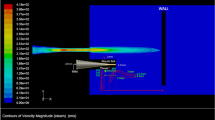Abstract
Mathematical simulation results for various modes of the steam jet efflux into atmosphere are represented. It is shown that, to describe processes in steam jet, in particular during coherent structure formation, there is a need to use a nonstationary model. Mathematical simulation results for the steam jet efflux into the atmosphere under various modes (subsonic, transonic, and supersonic) are described. Features of the formation and emission of noise by the steam jet are shown in dependence of its parameters at the exhaust line section. The obtained results are qualitatively compared with known experimental data on the location of the acoustical center of the steam jet and for instantaneous velocity field of the underexpanded air jet.
Similar content being viewed by others
References
V. B. Tupov, Factors through Which Thermal Power Plants Affect the Environment (MEI, Moscow, 2012) [in Russian].
V. T. Medvedev, V. B. Tupov, A. A. Taratorin, and B. V. Tupov, “Visualizing the pollution of environment with noise produced by thermal power plants,” Elektr. Stn., No. 3, 29–32 (2014).
V. B. Tupov, “A set of measures for reducing noise from thermal power plants,” Elektr. Stn., No. 3, 26–31 (2013).
D. I. Blokhintsev, Acoustics of Heterogeneous and Moving Medium, 2nd. ed. (Nauka, Moscow, 1981) [in Russian].
M. L. Shur, P. R. Spalart, and M. K. Strelets, “LES-based evaluation of a microjet noise reduction concept in static and flight condition,” J. Sound and Vibr. 330, 4083–4097 (2011).
A. S. Ginevskii, E. V. Vlasov, and R. K. Karavosov, Acoustic Control of Turbulent Jets (Fizmatlit, Moscow, 2001) [in Russian].
M. L. Shur, P. R. Spalart, and M. K. Strelets, “Noise reduction for increasingly complex jets. Part II: Applications,” Int. J. Aeroacoust. 4, 247–266 (2005).
D. V. Chugunkov, Development of Calculation Methods and Reduction of Noise from Underexpanded Steam Discharge Jets from Power-Generating Complexes, Candidate’s Dissertation in Technical Sciences (Moscow, 2007).
K. N. Volkov and V. N. Emel’yanov, Modeling of Large Vortices in Turbulent Flow Calculations (Fizmatlit, Moscow, 2008) [in Russian].
M. Samimy, K. S. Breuer, L. G. Leal, and P. H. Steen, A Gallery of Fluid Motion (Cambridge Univ. Press, 2003).
G. N. Abramovich, T. A. Girshovich, and S. Yu. Krasheninnikov, A Turbulent Jet Theory (Nauka, Moscow, 1984) [in Russian].
Author information
Authors and Affiliations
Corresponding author
Additional information
Original Russian Text © V.B. Tupov, A.A. Taratorin, 2015, published in Teploenergetika.
Rights and permissions
About this article
Cite this article
Tupov, V.B., Taratorin, A.A. Results of mathematical simulation of steam jet efflux in atmosphere under various modes affecting noise generation. Therm. Eng. 62, 365–369 (2015). https://doi.org/10.1134/S0040601515050134
Published:
Issue Date:
DOI: https://doi.org/10.1134/S0040601515050134



